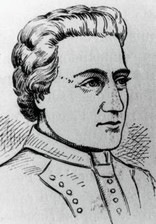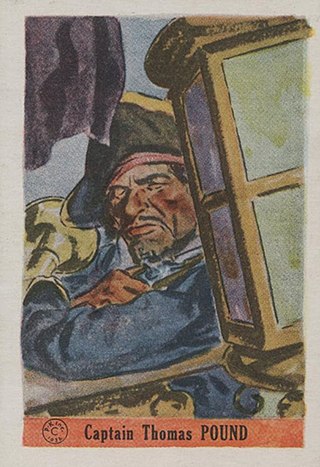
Alexander Selkirk was a Scottish privateer and Royal Navy officer who spent four years and four months as a castaway (1704–1709) after being marooned by his captain, initially at his request, on an uninhabited island in the South Pacific Ocean. He survived that ordeal but died from tropical illness years later while serving as a Lieutenant aboard HMS Weymouth off West Africa.

Queen Anne's War (1702–1713) was the second in a series of French and Indian Wars fought in North America involving the colonial empires of Great Britain, France, and Spain; it took place during the reign of Anne, Queen of Great Britain. In the United States, it is regarded as a standalone conflict under this name. Elsewhere it is usually viewed as the American theater of the War of the Spanish Succession. It is also known as the Third Indian War. In France it was known as the Second Intercolonial War.

Ipswich is a coastal town in Essex County, Massachusetts, United States. The population was 13,785 at the 2020 census. Home to Willowdale State Forest and Sandy Point State Reservation, Ipswich includes the southern part of Plum Island. A residential community with a vibrant tourism industry, the town is famous for its clams, celebrated annually at the Ipswich Chowderfest, and for Crane Beach, a barrier beach near the Crane estate. Ipswich was incorporated as a town in 1634.

John Winthrop the Younger was an early governor of the Connecticut Colony, and he played a large role in the merger of several separate settlements into the unified colony.

Fort Anne is a historic fort protecting the harbour of Annapolis Royal, Nova Scotia. It was built by Scottish settlers in August 1629 as Charles Fort. For the first 120 years of the fort's service period, the settlement of Port Royal, later Annapolis Royal, was the capital of the New France colony of Acadia and British North America colony of Nova Scotia. In 1917, Fort Anne became the first National Historic Site of Canada. Although no longer in active service, it is the oldest extant fort in Canada. Fort Anne has provided more defensive service than any other fort in North America, having been attacked and blockaded at least 19 times over a service period of 225 years, from the Acadian Civil War through to the American Revolutionary War. The fort also contains the oldest military building in Canada and the oldest building administered by Parks Canada, the 1708 powder magazine.

Daniel d'Auger de Subercase was a naval officer and the French governor of Newfoundland and later Acadia.

William Tailer was a military officer and politician in the Province of Massachusetts Bay. Born into the wealthy and influential Stoughton family, he twice married into other politically powerful families. He served as lieutenant governor of the province from 1711 until 1716, and again in the early 1730s. During each of these times he was briefly acting governor. He was a political opponent of Governor Joseph Dudley, and was a supporter of a land bank proposal intended to address the province's currency problems. During his first tenure as acting governor he authorized the erection of Boston Light, the earliest lighthouse in what is now the United States.

Thomas Pound was an English Royal Navy officer who turned pirate and was briefly active in the coastal waters of New England during 1689. Caught and convicted of piracy, his crimes were forgiven and he later rejoined the Royal Navy.

Col. Nathaniel Saltonstallc. 1639 – May 21, 1707 was a judge for the Court of Oyer and Terminer, a special court established in 1692 for the trial and sentence of people, mostly women, for the crime of witchcraft in the Province of Massachusetts Bay during the Salem Witch Trials. He is most famous for his resignation from the court, and though he left no indication of his feelings toward witchcraft, he is considered to be one of the more principled men of his time.

Greenwood Farm is a historic property and nature reserve located in Ipswich, Massachusetts, and owned by The Trustees of Reservations. The farm is 216 acres of gardens, pastures, meadows, woodlands and salt marsh and it features the PaineHouse, a First Period farmhouse constructed in 1694.
John March was in a variety of businesses in Newbury, Massachusetts. He was a colonel in the Massachusetts Bay militia and, in that position, was active in a number of military operations against the French and Indians by the English in King William's War and Queen Anne's War.

The Quebec expedition, or the Walker expedition to Quebec, was a British attempt to attack Quebec in 1711 in Queen Anne's War, the North American theatre of the War of Spanish Succession. It failed when seven transports and one storeship were wrecked and some 850 soldiers drowned in one of the worst naval disasters in British history.

The Battle of Bloody Creek was fought on 10/21 June 1711 during Queen Anne's War. An Abenaki militia successfully ambushed British soldiers at a place that became known as Bloody Creek after the battles fought there. The creek empties into the Annapolis River at present day Carleton Corner, Nova Scotia, and was also the location of a battle in 1757.

The siege of Port Royal in 1707 included two separate attempts by English colonists from New England to conquer Acadia by capturing its capital Port Royal during Queen Anne's War. Both attempts were made by colonial militia, and were led by men inexperienced in siege warfare. Led by Acadian Governor Daniel d'Auger de Subercase, the French troops at Port Royal easily withstood both attempts, assisted by irregular Acadians and the Wabanaki Confederacy outside the fort.

The siege of Port Royal, also known as the Conquest of Acadia, was a military siege conducted by British regular and provincial forces under the command of Francis Nicholson against a French Acadian garrison and the Wabanaki Confederacy under the command of Daniel d'Auger de Subercase, at the Acadian capital, Port Royal. The successful British siege marked the beginning of permanent British control over the peninsular portion of Acadia, which they renamed Nova Scotia, and it was the first time the British took and held a French colonial possession. After the French surrender, the British occupied the fort in the capital with all the pomp and ceremony of having captured one of the great fortresses of Europe, and renamed it Annapolis Royal.

James Kendall Hosmer was an American (Union) soldier during the American Civil War, a pastor, library director, historian, author and a professor of history and literature. Members of the Hosmer family fought in the French and Indian War, American Revolution and the Civil War. As a pastor of the First Church in Deerfield, Massachusetts he left the ministry, feeling duty bound to join the U.S. Army to serve in the Civil War, insisting to serve at the front, where he participated in several major campaigns. As an author and historian he later wrote and published several works about and involving the Civil War and how he viewed the cause of both the North and South. He also authored a number of other works relating to early American history, along with several novels and a fair number of poems. Hosmer also reviewed and published accounts about the Lewis and Clark Expedition at a time when full accounts of the expedition were very few in number and out of print. During his career he corresponded with many prominent writers and historians involving his works. In his latter life he held several prominent positions in various literary associations, including his position as president of the American Library Association.
Shadrach Walton was a British colonial administrator and soldier in the Province of New Hampshire.

Provincial troops were military units raised by colonial governors and legislatures in British North America for extended operations during the French and Indian Wars. The provincial troops differed from the militia, in that they were a full-time military organization conducting extended operations. They differed from the regular British Army in that they were recruited only for one campaign season at the time. These forces were often recruited through a quota system applied to the militia. Officers were appointed by the provincial governments. During the eighteenth century militia service was increasingly seen as a prerogative of the social and economic well-established, while provincial troops came to be recruited from different and less deep-rooted members of the community.
Brigadier-General John Townshend St Aubyn, 2nd Baron St Levan,, known as Hon. John Townshend St Aubyn from 1866 to 1908, was a British army officer and peer.

Sir Charles Hobby (1665–1715) was a Boston merchant and militia colonel, commanding a provincial regiment during the siege of Port Royal 1710, and serving as its acting governor in 1711. He was knighted in 1705.


















